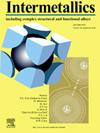Broadening the working temperature interval in a magneto-structural coupled Ni–Mn–Ga microparticle via introducing a free surface
IF 4.3
2区 材料科学
Q2 CHEMISTRY, PHYSICAL
引用次数: 0
Abstract
In the field of magnetic refrigeration, magnetic materials that can exhibit both a giant magnetic entropy change (ΔSm) and a widened working temperature interval (δTFWHM) are being pursued. To obtain an enhanced magnetic entropy change, this study designed a magneto-structural coupled (i.e., overlapping the martensitic and magnetic transitions) Ni–Mn–Ga bulk ingot; however, it possessed a relatively narrow δTFWHM of 10 K. To broaden its δTFWHM, a microparticle with size varying from ∼38.5 to 45 μm was produced by grinding the bulk ingot and by subsequently subjecting it to stress relief annealing (SRA). Consequently, an expanded martensitic transformation width of 14 K and a broadened δTFWHM of 15 K were achieved in the SRA state. Meanwhile, the average magnetic hysteresis was reduced from 21.8 J kg−1 to 16.8 J kg−1 by preparing the alloy in the microparticle configuration. Therefore, an enhanced net refrigeration capacity value of 104.0 J kg−1 under 5 T was achieved in the SRA microparticle compared with that of 57.7 J kg−1 in the bulk ingot. The strategy of increasing the specific surface area and regulating the internal stress can be used to expand a refrigerant's δTFWHM, thereby helping achieve a higher magnetic refrigeration capacity in Ni–Mn–X alloys.
求助全文
约1分钟内获得全文
求助全文
来源期刊

Intermetallics
工程技术-材料科学:综合
CiteScore
7.80
自引率
9.10%
发文量
291
审稿时长
37 days
期刊介绍:
This journal is a platform for publishing innovative research and overviews for advancing our understanding of the structure, property, and functionality of complex metallic alloys, including intermetallics, metallic glasses, and high entropy alloys.
The journal reports the science and engineering of metallic materials in the following aspects:
Theories and experiments which address the relationship between property and structure in all length scales.
Physical modeling and numerical simulations which provide a comprehensive understanding of experimental observations.
Stimulated methodologies to characterize the structure and chemistry of materials that correlate the properties.
Technological applications resulting from the understanding of property-structure relationship in materials.
Novel and cutting-edge results warranting rapid communication.
The journal also publishes special issues on selected topics and overviews by invitation only.
 求助内容:
求助内容: 应助结果提醒方式:
应助结果提醒方式:


